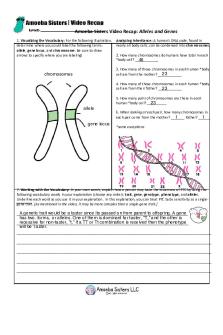Genes and genetic diseases Worksheet PDF

| Title | Genes and genetic diseases Worksheet |
|---|---|
| Course | Altered Physiology: Mechanisms of Disease I |
| Institution | University of Ontario Institute of Technology |
| Pages | 3 |
| File Size | 80.4 KB |
| File Type | |
| Total Downloads | 71 |
| Total Views | 145 |
Summary
Download Genes and genetic diseases Worksheet PDF
Description
Genetic diseases WORKSHEET
1. Down syndrome usually occurs because of: a. an abnormal X chromosome. b. nondisjunction by older ova. c. an autosomal dominant gene. d. an autosomal recessive gene. 2. Fragile X syndrome can affect intelligence and behavior in: a. males only. b. females only. c. both males and females. d. neither because affected fetuses are aborted. 3. If homologous chromosomes fail to separate during meiosis, the disorder is: a. polyploidy. b. aneuploidy. c. disjunction. d. nondisjunction. e. translocation. 4. In autosomal dominant inherited disorders: a. affected individuals do not have an affected parent. b. affected individuals who mate with unaffected people have a 50% risk of having an affected off-spring. c. male offspring are most often affected. d. unaffected children born to affected parents will have affected children. 5. Which of the following is FALSE of X-linked recessive inherited disorders? a. affected males have normal sons. b. affected males have affected daughters. c. sons of female carriers have a 50% risk of being affected. d. the affected male transmits the gene to all daughters, thus, they are carriers. 6. If a male inherits an autosomal recessive disorder, he inherited it from his: a. mother. b. father. c. mother and father. 7. Trisomy 21 syndrome is caused by: a. paternal disjunction. b. maternal disjunction. c. maternal translocation. d. maternal nondisjunction.
1
Genetic diseases WORKSHEET
2
Match the term with the correct circumstance. ____ 8. Recessive disorder a. due to numerical or structural aberrations ____ 9. Genotype b. gene combination ____ 10. Aneuploidy c. a cell with fewer or more chromosomes than normal ____ 11. Chromosomal aberration d. individual homozygous for a gene ____ 12. Phenotype e. failure of homologous chromosomes to separate ____ 13. Autosomal recessive during meiosis or mitosis inheritance f. outward appearance of an individual g. a probability of 0.25 h. expresses genes Match the term with the correct circumstance. ____ 14. Expressivity a. a probability of 0.5 ____ 15. X-linked b. females unlikely to be affected ____ 16. Inversion c. species chromosomal morphology ____ 17. Dominant trait d. one allele permits expression e. extent of phenotypic variation of a particular genotype f. different version of the same paired gene g. no loss or gain of genetic material For each statement, write T (true) or F (false) in the blank provided. ____ 18. Hypertension is a multifactorial disease. ____ 19. A multifactorial trait is expressed when multiple genes and environmental influences blend together. ____ 20. In Down syndrome, the pathology is manifested independent of environment. ____ 21. It is easy to distinguish between the effect of shared environmental factors and the effects of a common pool of genes. ____ 22. Relative risk is a ratio between incidence and individuals. ____ 23. Early type 2 diabetes may develop when an individual’s diet changes to include heavy carbohydrate consumption. ____24. Finding and understanding environmental factors that affect the penetrance of specific genes are important if chronic familial diseases are to be prevented. ____ 25. The frequency of genetic disease in the population depends on phenotypes. ____ 26. Risk factors, when removed or eliminated, delay or prevent disease. ____ 27. The recurrence risk is less when more than one sibling is affected. ____ 28. The existence of a particular risk factor indicates that an individual will develop a specific disease. ____ 29. The expression of a disease may require both an inherited defect and environmental exposure. ___ 30. Multifactorial diseases can change substantially from one population to another because gene frequencies and environments differ.
Genetic diseases WORKSHEET
ANSWER KEY 1. b 2. c 3. d 4. b 5. b 6. c 7. d 8. d 9. b 10. c 11. a 12. f 13. g 14. i 15. b 16. h 17. d 18. T 19. T 20. T 21. F 22. T 23. T 24. T 25. F 26. T 27. F 28. F 29. T 30. T
3...
Similar Free PDFs

Health and Diseases Vocabulary
- 6 Pages

Chapter 24 - Genes and Chromosomes
- 10 Pages

Vulval diseases
- 1 Pages

Genes to organisms
- 5 Pages

Genes letales 1
- 7 Pages
Popular Institutions
- Tinajero National High School - Annex
- Politeknik Caltex Riau
- Yokohama City University
- SGT University
- University of Al-Qadisiyah
- Divine Word College of Vigan
- Techniek College Rotterdam
- Universidade de Santiago
- Universiti Teknologi MARA Cawangan Johor Kampus Pasir Gudang
- Poltekkes Kemenkes Yogyakarta
- Baguio City National High School
- Colegio san marcos
- preparatoria uno
- Centro de Bachillerato Tecnológico Industrial y de Servicios No. 107
- Dalian Maritime University
- Quang Trung Secondary School
- Colegio Tecnológico en Informática
- Corporación Regional de Educación Superior
- Grupo CEDVA
- Dar Al Uloom University
- Centro de Estudios Preuniversitarios de la Universidad Nacional de Ingeniería
- 上智大学
- Aakash International School, Nuna Majara
- San Felipe Neri Catholic School
- Kang Chiao International School - New Taipei City
- Misamis Occidental National High School
- Institución Educativa Escuela Normal Juan Ladrilleros
- Kolehiyo ng Pantukan
- Batanes State College
- Instituto Continental
- Sekolah Menengah Kejuruan Kesehatan Kaltara (Tarakan)
- Colegio de La Inmaculada Concepcion - Cebu










